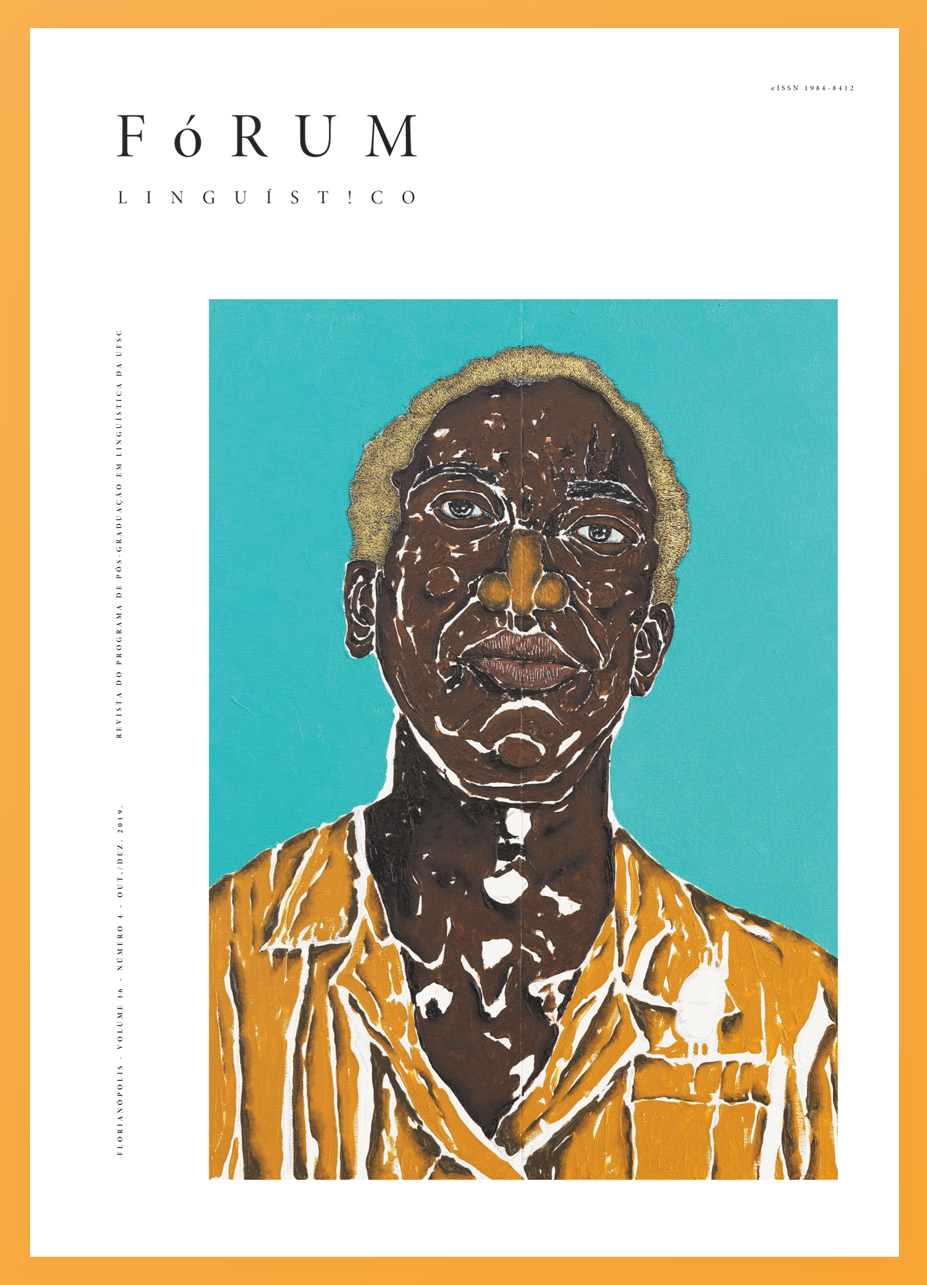A paisagem sócio-linguística: a política, a diversidade e a migração no espaço público
DOI:
https://doi.org/10.5007/1984-8412.2020.e72231Resumo
No presente artigo, discute-se o conceito acerca da paisagem linguística. Combinando os métodos etnográficos com os linguísticos, visa-se fornecer uma imagem mais completa de dois lugares diversos: a da cidade suburbana de Varsóvia e a de uma colônia habitada por descendentes de migrantes poloneses no Brasil. Argumenta-se que a análise dos aspectos materiais do espaço público observados nestas regiões, bem como os provenientes dos encontros etnográficos, nos permite entender melhor a visibilidade e a invisibilidade dos vários grupos em questão. Por outro lado, nos permite também observar diversas práticas de comunicação formais e informais e reconhecer o espaço limitado para expressar a diversidade linguística e étnica, acessível para aqueles que habitam o município. Além disso, acredita-se que a análise da comunicação escrita é insuficiente, porque alguns grupos estão presentes mais auditivamente do que visualmente.
Referências
BARANOVA, V.; FEDOROVA, K. Invisible minorities” and “hidden diversity” in Saint-Petersburg's linguistic landscape. Language and Communication, n. 68 p.17-27, 2019.
BEN-RAFAEL, E.; SHOHAMY,E.; AMARA , M. H.; TRUMPER-HECHT, N. Linguistic landscape as symbolic construction of the public space: the case of Israel. International Journal of Multilingualism, v.3. n. 1, p. 7-30, 2006.
BIELENIN-LENCZOWSKA, K.; STĄPOR I. Língua como patrimônio cultural. Práticas linguísticas dos descendentes dos poloneses no sul do Brasil. Revista del CESLA n. 20, p. 39-55, 2017.
BIELENIN-LENCZOWSKA, K. Pierogi z fiżonem. Praktyki jedzeniowe i tożsamość Brazylijczyków polskiego pochodzenia w południowobrazylijskiej wsi, Studia Migracyjne – Przegląd Polonijny, n.167, p. 23-47, 2018.
BLOMMAERT, J. The conservative turn in Linguistic Landscape Studies. 2016. Disponível em: http://alternative-democracy-research.org/2016/01/05/the-conservative-turn-in-linguistic-landscape-studies. Acesso em: 11 abr. 2020.
BLOMMAERT, J. Ethnography, superdiversity and linguistic landscapes. Bristol, U.K.: Multilingual Matters, 2013.
BLOMMAERT, J.; MALY, I. Ethnographic linguistic landscape analysis and social change: A case study. Tilburg Papers in Culture Studies, n. 100, p. 1-27, 2014.
BRECKNER I.; PEUKERT H.; PINTO A. The delicate search for language in spaces. Multilingualism as a resource in urban development? In: SIEMUND P. et al. (org.) Multilingualism and Language Diversity in Urban Areas. Acquisition, identities, space, education. Amsterdam / Philadephia: John Benjamins Publishing Co., 2013. p. 210-226.
BUCHOWSKI, M. Making Anthropology matter in the heyday of islamophobia and the 'Refugee Crisis': the case of Poland. Český lid: etnologický časopis v. 103, n.1, p. 51-67, 2016.
DEINA M. . Colônia Rio Claro. Esta terra tem história. Curitiba: Gráfica Vicentina, 1990.
ENGESET-POGRANICZNA, M. 2018. Kebab nasz powszedni. Magazyn kontakt. available online: http://magazynkontakt.pl/kebab-nasz-powszedni.html.
GOCZYŁA FERREIRA, A. 2019. A presença da língua polonesa na Colônia Dom Pedro II, Campo Largo, Paraná. Dissertação (Mestrado em Letras) – Setor de Ciências Humanas da Universidade Federal do Paraná, Curitiba, 2019
GOGOLIN I., SIEMUND P., SCHULZ M., DAVYDOVA J. 2013. Multilingualism, language contact, and urban areas. Multilingualism and Language Diversity in Urban Areas. In: SIEMUND P. et al. (org.) Multilingualism and Language Diversity in Urban Areas. Acquisition, identities, space, education. Amsterdam / Philadephia: John Benjamins Publishing Co., 2013, p. 1-15.
HIRSCH E., O'HANLON M. (org.). Anthropology of landscape. Perspectives on place and space. Oxford: Oxford University Press, 1995.
JIA LOU, J. The linguistic landscape of Chinatown. A sociolinguistic ethnography. Bristol, Buffalo: Multilingual Matters, 2016.
JÓŹWIAK I., PIECHOWSKA M. 2017. Crisis-driven mobility between Ukraine and Poland. What does the available data (not) tell us. CMR Working Papers, n.99, p. 1-26, 2017.
KINDLER, M. A ‘Risky’ Business? Ukrainian migrant women in Warsaw's domestic work sector: Amsterdam: Amsterdam University Press, 2011.
LANDRY R.; BOURHIS, R. Y. Linguistic Landscape and Ethnolinguistic Vitality: An Empirical Study. Journal of Language and Social Psychology, v.16, n.1, p. 23-49, 1997.
NEKVAPIL, J. Language biographies and the analysis of language situations: on the life of the German community in the Czech Republic. International Journal of the Sociology of Language, n.162, p. 63-83, 2003.
PIŁAT, A. Obcokrajowcy mieszkający w gminie Raszyn - wzory integracji i relacje ze społecznością lokalną. In: Mała Azja w Polsce. Plany i strategie imigrantów z Azji i Bliskiego Wschodu w Polsce. Warszawa: Instytut Spraw Publicznych, 2013.
SZYMAŃSKA-MATUSIEWICZ, G. Migration and cultural flows between Vietnam and Poland. Asian and Pacific Migration Journal, p. 1-21, 2016.
TRINCH, Sh.; SNAJDR, E. What the signs say: gentrification and the disappearance of capitalism without distinction in Brooklyn. Journal of Sociolinguistics, v.21, n.1, p. 64-89, 2017.
VERTOVEC, S. Super-diversity and its implications. Ethnic and Racial Studies, v.30, n.6, p. 1024-1054, 2007.
SAMUELS, D. W.; MEINTJES, L.; OCHOA, A.M.; PORCELLO, T. Soundscapes: toward a sounded anthropology. Annual Review of Anthropology, v. 39, p. 329-345, 2010.
WALASZEK A. (org.). Polska diaspora. Kraków: Wydawnictwo Literackie, 2001.
WOLDEMARIAM H., LANZA E. Imagined community. The linguistic landscape in a diaspora. Linguistic Landscape 1, n. 1-2, p. 172-190, 2015.
WOOLARD, K. Introduction: Language ideology as a field of inquiry. In: BAMBI, B. et al. (org.). Language ideologies: practice and theory. New York: Oxford University Press, 1998. p. 3-47.
Downloads
Publicado
Edição
Seção
Licença
Copyright (c) 2020 Fórum Linguístico

Este trabalho está licenciado sob uma licença Creative Commons Attribution-NonCommercial-NoDerivatives 4.0 International License.
Os trabalhos publicados passam a ser de direito da Revista Fórum Linguístico, ficando sua reimpressão, total ou parcial, sujeita à autorização expressa da Comissão Editorial da revista. Deve ser consignada a fonte de publicação original.
Esta publicação está regida por uma licença Creative Commons Attribution-NonCommercial-NoDerivatives 4.0 International License.



